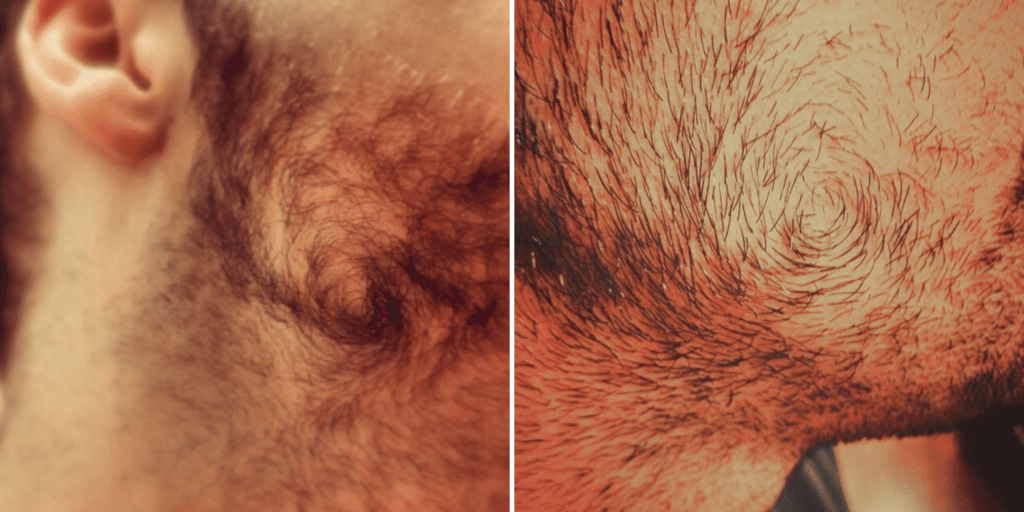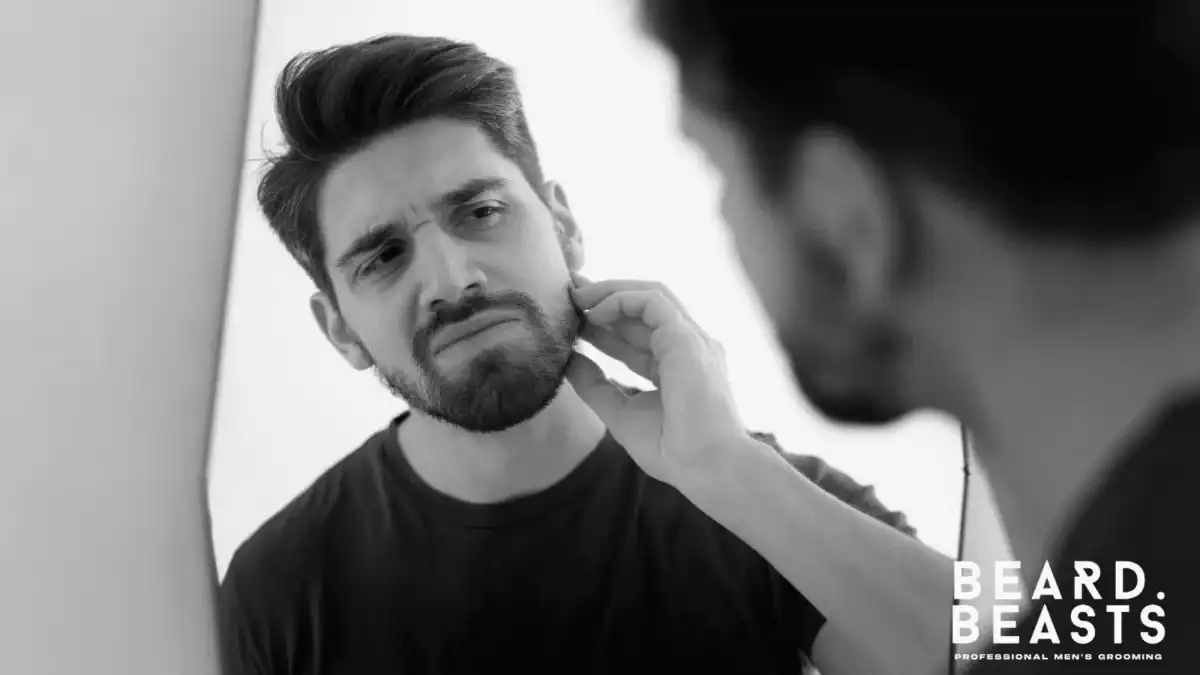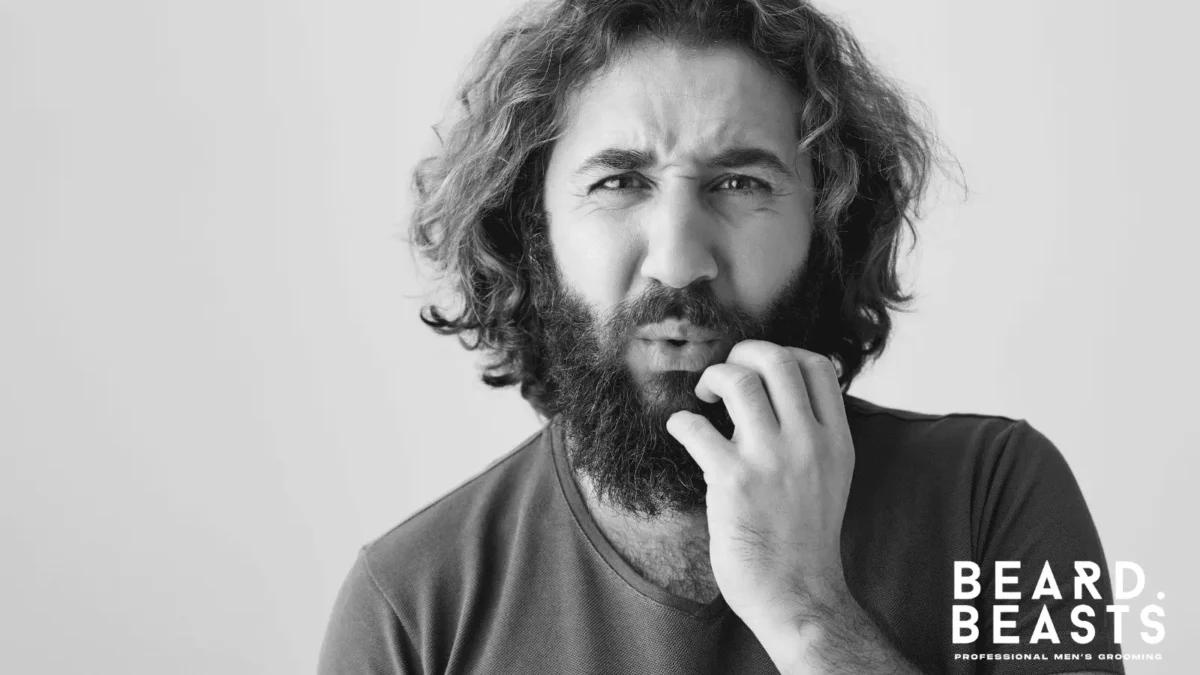A beard cowlick is a common grooming challenge that many beard enthusiasts face. This quirky patch of hair grows in a different direction from the rest of your beard, making it tricky to tame. But don’t worry—managing a beard cowlick is entirely doable with the right knowledge and tools.
In this article, we’ll dive into the causes, management tips, and styling techniques to help you keep your beard looking its best. From daily care routines to professional advice, we’ve got you covered. Let’s explore how to transform your beard cowlick from a hassle into a unique feature of your style.
What is a Beard Cowlick?
A beard cowlick is a common and often frustrating phenomenon where a patch of beard hair grows in a different direction than the rest of your beard. This can create an unruly spot that sticks out and can be difficult to manage. Let’s break down what a beard cowlick is all about:

Definition and Characteristics
A beard cowlick is essentially a stubborn tuft of hair that defies the natural flow of your beard. It can make your beard look uneven or unkempt, even if you’ve put in the effort to groom it. Here are some key characteristics:
- Stubborn growth: The hair in a cowlick area grows in a swirl or different direction.
- Noticeable: It stands out against the rest of your neatly groomed beard.
- Persistent: Cowlicks tend to resist taming efforts like brushing or trimming.
Common Areas Where Beard Cowlicks Occur
Beard cowlicks can pop up in various spots on your face, but some areas are more prone to them than others. Here are the usual suspects:
- Chin: Right in the center, where the hair can swirl.
- Jawline: Particularly along the sides, where hair might grow in a different direction.
- Cheeks: Often around the lower cheek area.
- Moustache: The area just above your lips can also develop cowlicks.
Quick Facts About Beard Cowlicks
- Genetics play a big role: If your dad or grandfather had a beard cowlick, you might have one too.
- Not a flaw: It’s a natural characteristic of hair growth and not a sign of poor grooming.
- Manageable: With the right techniques and products, you can tame even the most stubborn cowlicks.
In conclusion, a beard cowlick is just one of those quirks that come with growing a beard. By understanding what it is and where it typically occurs, you can take steps to manage it effectively and keep your beard looking its best.
Causes of Beard Cowlicks
Understanding the causes of a beard cowlick can help you manage and even embrace this quirky aspect of beard growth. Let’s dive into the main reasons why beard cowlicks occur:
Genetic Factors
Genetics play a significant role in the formation of beard cowlicks. If you have family members with cowlicks, there’s a good chance you might develop them too.
- Inherited traits: Your DNA determines the direction and pattern of your hair growth.
- Family history: If your father or grandfather had a beard cowlick, you might inherit this characteristic.
Hair Growth Patterns
The natural way your hair grows can lead to the formation of a beard cowlick. Here are some key points about hair growth patterns:
- Growth direction: Hair follicles are angled in specific ways, and when they grow out, they create patterns.
- Swirls and whorls: These are natural occurrences where hair grows in a circular or spiral pattern, leading to cowlicks.
Skin Conditions Affecting Beard Growth
Certain skin conditions can affect the way your beard grows, potentially causing cowlicks:
- Dry skin: Flaky or dry skin can disrupt the uniform growth of hair.
- Acne or scars: Areas with acne or scars may cause hair to grow in different directions.
External Factors
External factors, such as your daily habits and grooming routines, can also contribute to the formation of a beard cowlick:
- Sleeping habits: The way you sleep can press and mould your beard hair into certain patterns.
- Beard care routines: Inconsistent grooming practices, like irregular brushing or improper use of products, can influence hair growth direction.
In conclusion, beard cowlicks are caused by a mix of genetic factors, natural hair growth patterns, skin conditions, and external influences. By understanding these causes, you can better manage your beard and keep those cowlicks under control.
How to Identify a Beard Cowlick
Spotting a beard cowlick early can save you a lot of grooming headaches. Here’s how to identify one:
Visual Cues and Signs
A beard cowlick is often easy to spot once you know what to look for. Here are some visual cues:
- Swirling patterns: Look for areas where your beard hair seems to grow in a circular or spiral pattern.
- Hair sticking out: Notice if there are patches where the hair refuses to lie flat or follow the rest of your beard’s direction.
- Uneven texture: Check for spots where the hair feels rougher or looks more unruly compared to the rest of your beard.
Common Symptoms and Challenges
Identifying a beard cowlick isn’t just about how it looks. You might also experience some challenges:
- Difficulty styling: You might find it hard to brush or comb certain parts of your beard into place.
- Persistent unruliness: No matter how much product you use, that one spot just won’t behave.
- Asymmetry: Your beard might look lopsided or uneven because of the cowlick.
Importance of Early Identification
Catching a beard cowlick early is crucial for a few reasons:
- Easier management: The sooner you identify the cowlick, the quicker you can start using techniques and products to tame it.
- Prevents bad habits: Early identification helps you avoid grooming habits that might make the cowlick worse.
- Better styling options: Knowing you have a cowlick allows you to choose beard styles that accommodate or even highlight this unique feature.
In conclusion, identifying a beard cowlick involves looking for visual cues like swirling patterns and beard hair sticking out, recognizing common symptoms like difficulty styling, and understanding the importance of early detection. By spotting a cowlick early, you can manage it more effectively and maintain a well-groomed beard.
Management of Beard Cowlicks
Managing a beard cowlick can be a bit tricky, but with the right routine and products, you can keep it under control. Here’s a friendly guide to help you manage your beard cowlick effectively.
Daily Beard Care Routine
Importance of Regular Washing and Conditioning
Keeping your beard clean and well-conditioned is the foundation of good beard care. Regular washing and conditioning help keep your beard soft and manageable, making it easier to tame those stubborn cowlicks.
- Regular washing: Use a gentle beard shampoo to clean your beard without stripping it of natural oils.
- Conditioning: Apply a beard conditioner or a leave-in conditioner to keep your beard soft and hydrated.
Recommended Beard Shampoos and Conditioners
Using the right products is crucial for managing a beard cowlick. Here are some top picks:
- Ultra Soft Beard Wash: Our specially formulated wash is gentle on your beard, providing a deep clean without drying out your hair.
- Conditioners: Choose beard conditioners that contain natural oils like jojoba or argan oil.
Tips for Proper Beard Drying
How you dry your beard can make a big difference in managing a cowlick:
- Pat dry with a towel: Gently pat your beard dry instead of rubbing it to avoid frizz and breakage.
- Use a blow dryer: Set it to a low heat setting and use a round brush to guide the hair in the desired direction.
Trimming and Shaping Techniques
Tools Required for Managing a Beard Cowlick
Having the right tools makes managing a beard cowlick much easier:
- Quality beard trimmer: The Philips Norelco Series 9000 Beard Trimmer is an excellent choice for precise trimming with adjustable settings.
- Sharp scissors: For precise cutting and shaping.
- Comb and brush: Use our Stainless Steel Beard Comb for detangling and our Hardwood Boar Bristle Beard Brush for smoothing and styling.
Step-by-Step Guide to Trimming and Shaping
- Comb your beard: Start by combing your beard to identify the cowlick and plan your trimming.
- Trim the cowlick area: Use the trimmer to even out the length of the cowlick area with the rest of your beard.
- Use scissors for precision: Trim any stray hairs with scissors for a clean look.
- Shape your beard: Follow your natural beard lines, using the trimmer and scissors to maintain a well-groomed shape.
Frequency of Trimming
- Regular trims: Trim your beard every 1-2 weeks to keep the cowlick in check.
- Minor touch-ups: Perform minor touch-ups as needed to maintain a neat appearance.
Using Beard Products
Types of Products: Oils, Balms, and Waxes
Using the right beard products can help manage a beard cowlick effectively:
- Beard oils: Keep your beard soft and hydrated. Great for daily use.
- Beard balms: Provide a light hold and help shape your beard.
- Beard waxes: Offer a stronger hold, ideal for taming stubborn cowlicks.
How to Apply Products Effectively
- Beard oils: Apply a few drops of beard oil to your hands, rub them together, and massage the oil into your beard, focusing on the cowlick area.
- Beard balms: Scoop a small amount of balm, warm it between your palms, and work it through your beard, shaping it as you go.
- Beard waxes: Use a small amount of wax, warm it between your fingers, and apply it to the cowlick area to hold the hair in place.
Product Recommendations for Taming Cowlicks
- Beard oils: Our Sandalwood Beard Oil is perfect for keeping your beard soft and smelling great.
- Beard balms: Try our King Beard Balm for a light hold that helps shape and tame your beard.
- Beard waxes: For a stronger hold, consider using a high-quality beard wax.
By following these tips and using our recommended products like Ultra Soft Beard Wash, Sandalwood Beard Oil, and King Beard Balm, along with tools like the Philips Norelco Series 9000 Beard Trimmer, our Stainless Steel Beard Comb, and our Hardwood Boar Bristle Beard Brush, you can keep your beard looking its best and maintain control over those pesky cowlicks.
Styling Tips for Beard Cowlicks
Once you’ve managed your beard cowlick with a good care routine and the right products, it’s time to focus on styling. Here are some friendly tips to help you tame that cowlick and keep your beard looking sharp.
Techniques for Taming a Cowlick
Brushing and Combing Strategies
Brushing and combing your beard properly can help control a cowlick and keep your beard looking neat:
- Brush regularly: Use our Hardwood Boar Bristle Beard Brush to distribute natural oils and smooth out the beard.
- Comb strategically: Our Stainless Steel Beard Comb can help detangle and guide your beard hair in the desired direction. Comb your beard when it’s slightly damp for best results.
Using Heat Tools
Heat tools can be very effective in taming a stubborn beard cowlick:
- Hairdryers: Use a hairdryer on a low heat setting while brushing your beard. This helps set the hair in place.
- Straighteners: If your cowlick is particularly stubborn, a beard straightener can help. Use it sparingly to avoid damaging your hair.
Styling Tips for Different Beard Lengths and Styles
Different beard lengths require different approaches to manage a cowlick:
- Short beards: Keep the hair trimmed and neat. Use balm or wax to hold the cowlick in place.
- Medium beards: Regularly brush and use a blow dryer to guide the hair. Beard oil can help soften and control the hair.
- Long beards: Regularly trim split ends and use a combination of oil, balm, and heat to manage the cowlick.
Popular Beard Styles for Cowlicks
Choosing the right beard style can help minimize the appearance of a cowlick:
Styles that Minimize the Appearance of Cowlicks
- Medium Boxed Beard: This style is neat and easy to maintain, making cowlicks less noticeable.
- Stubble: Keeping your beard short and trimmed to stubble length can help blend in cowlicks.
- Faded Beard: With the right care and grooming, a faded beard can camouflage a cowlick on your cheeks by blending it into the overall beard volume.

Including visual aids can help you see how different styles look. Look for beard style guides online or visit our website for examples.
How to Choose a Style that Suits Your Face Shape and Hair Type
- Face shape: Choose a style that complements your face shape. For example, a square face looks great with a fuller beard, while an oval face can pull off almost any style.
- Hair type: Consider your hair type. Thicker hair might need more product to manage a cowlick, while finer hair can often be tamed with less.
Quick Styling Tips
- Be consistent: Regular grooming helps keep your beard cowlick under control.
- Use the right products: Our Sandalwood Beard Oil and King Beard Balm are perfect for daily use.
- Visit a barber: Professional barbers can offer tips and help you maintain your style.
By following these styling tips and choosing the right beard style, you can manage your beard cowlick effectively and keep your beard looking its best. With the right care and a little bit of patience, you can turn a cowlick from a challenge into a unique feature of your personal style.
Frequently Asked Questions
When it comes to dealing with a beard cowlick, you’re not alone. Many people have questions about how to manage this common issue. Here are some frequently asked questions and helpful answers.
Can You Fix a Beard Cowlick?
While you might not be able to completely eliminate a beard cowlick, you can definitely manage and minimize its appearance:
- Regular trimming: Keeping your beard well-trimmed can help control the cowlick.
- Using products: Apply beard oils, balms, or waxes to soften and hold the hair in place. Our Sandalwood Beard Oil and King Beard Balm are excellent choices.
- Heat tools: Using a blow dryer or a beard straightener can help set the hair in the desired direction.
What Causes a Cowlick in the Beard?
Several factors can cause a beard cowlick:
- Genetics: The most common reason. If your family members have cowlicks, you likely will too.
- Hair growth patterns: Natural growth directions and patterns of your beard hair can create cowlicks.
- Skin conditions: Dry skin, acne, or scarring can affect hair growth direction.
- External factors: Daily habits like how you sleep or how you groom your beard can influence the formation of cowlicks.
How to Shave a Beard Cowlick?
Shaving around a beard cowlick requires a bit of care to maintain a neat look:
- Identify the cowlick area: Use a mirror to clearly see the cowlick and plan your approach.
- Trim first: Use a quality trimmer like the Philips Norelco Series 9000 Beard Trimmer to shorten the hair around the cowlick.
- Shave carefully: If you’re shaving clean around the cowlick, use a sharp razor and shave in the direction of hair growth to avoid irritation.
- Post-shave care: Apply a soothing aftershave balm to prevent irritation and ingrown hairs.
In conclusion, while a beard cowlick can be challenging, understanding its causes and learning how to manage it can make a big difference. With regular care, the right products, and perhaps a bit of professional help, you can keep your beard looking stylish and well-groomed.
Conclusion
Dealing with a beard cowlick might seem daunting at first, but with the right knowledge and tools, you can manage it effectively and keep your beard looking sharp. Let’s recap the key points:
Key Takeaways:
- Understanding: Recognize that a beard cowlick is a common occurrence influenced by genetics, hair growth patterns, and external factors.
- Daily Routine: Implement a consistent beard care routine, including regular washing, conditioning, and proper drying techniques.
- Trimming and Shaping: Use quality tools like the Philips Norelco Series 9000 Beard Trimmer, our Stainless Steel Beard Comb, and Hardwood Boar Bristle Beard Brush for precision grooming.
- Product Use: Apply beard products such as our Ultra Soft Beard Wash, Sandalwood Beard Oil, and King Beard Balm to tame and style your beard.
- Professional Help: Don’t hesitate to seek the expertise of a professional barber for tailored advice and grooming.
Quick Tips for Success:
- Be consistent: Regular care and maintenance go a long way in managing a beard cowlick.
- Stay patient: Taming a cowlick can take time and persistence.
- Experiment: Try different styles and products to find what works best for you.
Remember, a beard cowlick doesn’t have to be a hassle. With the right approach, it can even add a unique character to your beard. Embrace the process of learning and experimenting with different techniques and products. Your beard is a significant part of your style and identity, so take pride in grooming it well.





